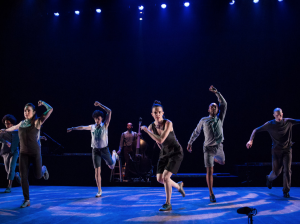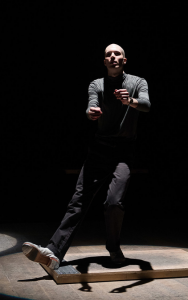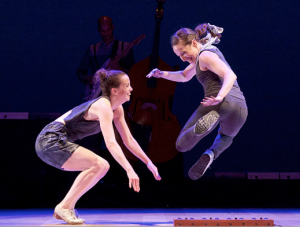A downpour where you can hear individual raindrops: Dorrance Dance

Michelle Dorrance (center) with her company. Photo: Matt Murphy
One of my peak moments, watching Dorrance Dance’s virtuoso tap dancing last week, was when Warren Craft fell. Craft, tall and stoop-shouldered, has a loose, almost gawky style. He was launching himself into slides across the floor, and at one point he did it with so much abandon that whoops! His feet went out from under him. Then he bounced up again.
That abandon, the willingness to ride the edge and sometimes you go over, is one of many thrills the New York company delivered in a show presented by ArtPower. Tappers see themselves as percussionists; some mike their shoes. Michelle Dorrance and her collaborators take it several steps—make that several leaps—forward.
The company’s associate artistic director, Nicholas Van Young, has created “trigger boards” that dancers can step on and produce a palette of sounds: electronic burps, marimba-like tones, and of course drum beats, often enhanced with looping—all of that blending with several onstage musicians.

Warren Craft with a trigger board. Photo: Christopher Duggan
In one section, a line of trigger boards became piano keys, the dancers stepping agilely, sometimes having to cross back on themselves, to play a tune. Van Young has worked in EDM (electronic dance music), and the show is called “ETM: Double Down”— in other words, electronic tap music with a gambler’s sense of risk.
The risk is real. The danger of amplifying tappers’ footfalls, especially with up to eight dancers onstage, is that if anyone goes a hair off-beat or doesn’t tap cleanly, it’s exposed. Dorrance and her seven dancers nailed it, whether in tight unison or doing a counterpoint like a downpour of sound—a downpour in which you can hear individual raindrops, they’re that precise.
Once, it felt like too much—when angelic-voiced Aaron Marcellus was singing a sweet tune, and multiple tappers almost drowned him out. But only once.
Dorrance herself is a powerhouse whose feet move at seemingly inhuman speed, heels and toes driving into the stage, sides of her shoes scraping in ronds de jambe. She dove gleefully into tap battles and sometimes picked up a drum and played.

Michelle Dorrance and Ephrat “Bounce” Asherie. Photo: Elliott Franks
Tap history includes the showmanship of Hollywood musicals—smile smile smile, and dance with a relatively high center of gravity—and the hunkered, “I don’t care about the audience” style of the brilliant Gregory Hines and Savion Glover. Dorrance Dance took it all the way to the ground, Ephrat “Bounce” Asherie adding B girl moves. (Asherie, a joyful imp of a dancer, brought her company here in March in another landmark performance.) They also showed some Hollywood style, sometimes facing us and grinning like happy kids who were having as much fun dancing as I did, watching them.
I saw Dorrance Dance perform another piece, “Myelination” in Los Angeles in Fall, 2017. There, too, the dancing dazzled me, but the piece didn’t fully cohere as an evening-length work. In “ETM: Double Down,” everything came together, under mostly-overhead lighting by Kathy Kaufman that bathed the dancers in radiance.

Award-winning dance journalist Janice Steinberg has published more than 400 articles in the San Diego Union-Tribune, Dance Magazine, the Los Angeles Times, and elsewhere. She was a 2004 New York Times-National Endowment for the Arts fellow at the Institute for Dance Criticism and has taught dance criticism at San Diego State University. She is also a novelist, author of The Tin Horse (Random House, 2013). For why she’s passionate about dance, see this article on her web site, The Tin Horse

Thanks for all of your clear-sighted writing. We are lucky to have a critic who knows and loves dance.